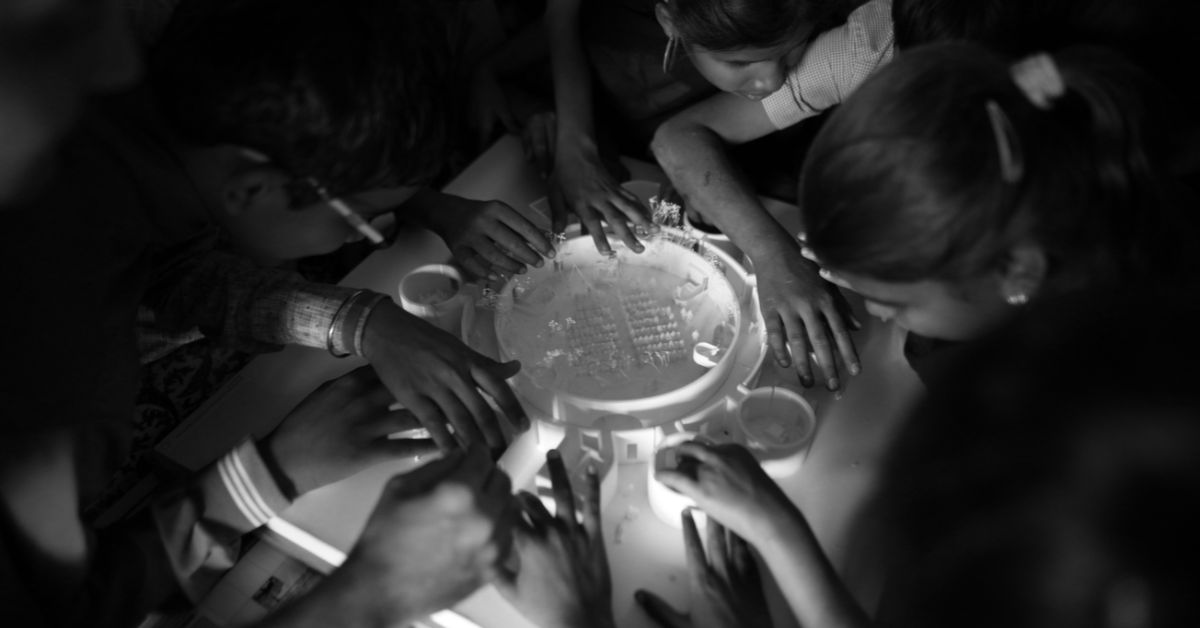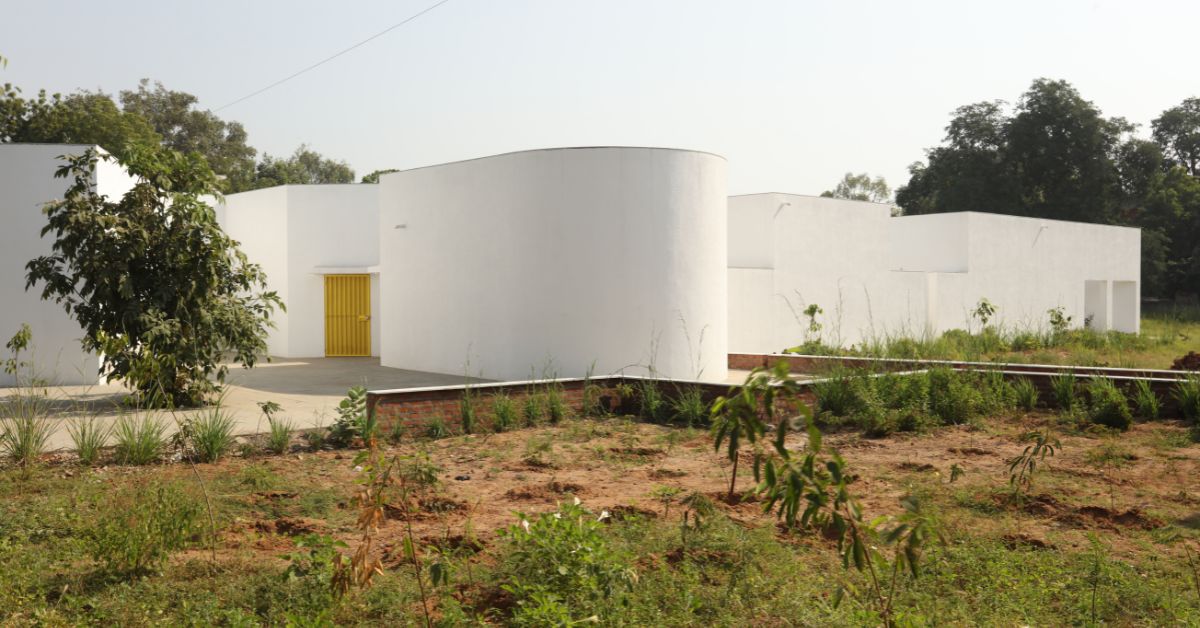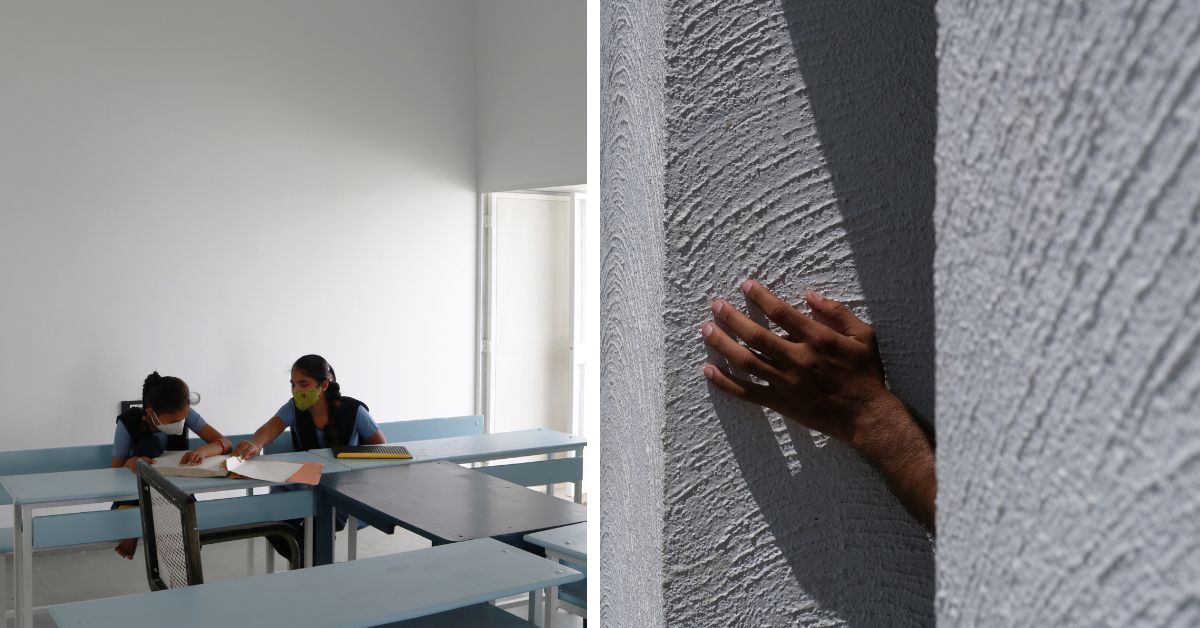Image this — a faculty particularly designed to cater to the wants of these with visible disabilities. And bringing this to fruition is a faculty in Gandhinagar, Gujarat, setting the bar excessive for its inclusive architectural design.
With its distinctive building and considerate design, the college empowers kids to depend on their different senses to navigate by the academic area.
Adorned with white partitions and ethereal courtyards, ‘The Faculty for The Blind and Visually Impaired’, designed by SEALABS, is devoted to those explicit college students.
“Each visually impaired baby has completely different wants, and we needed to create an area that was inclusive of all of them,” says Anand Sonecha, the architect of SEALABS, talking to The Higher India.
So, how does this college assist its kids navigate? I’m glad you requested!
‘Discovered inspiration in lots of place’
Anand began his follow again in 2015 and had by no means labored on creating a faculty earlier than. “When Viren Joshi, the president of the college, approached me to take a look, I used to be very honoured. I used to be excited to get to the college and begin the designing course of,” he shares.
Explaining the concept behind the college, he says, “There was an current constructing however was in a nasty situation. It was a faculty for underprivileged kids with visible impairment.”
There have been two buildings — one was a hostel facility and the opposite one was the college. “In every room, twelve to fifteen college students have been dwelling in bunk beds. Consequently, a choice was made to assemble a brand new educational constructing and convert the present construction solely right into a hostel facility. This could enable for redistribution of scholars throughout the bottom and first flooring, whereas offering them with extra snug and improved dwelling areas.”
Whereas Anand was excited to get on board the undertaking, he lacked a supply of inspiration. To seek out that, he determined to spend time with the youngsters.
“I started observing how college students navigate by completely different locations and areas, figuring out their preferences and gathering spots. Moreover, I made mates with college students to raised perceive their every day routines, likes, and dislikes throughout the current college. Equally, I engaged in discussions with academics to discover methods to reinforce the educational surroundings,” he says.
Moreover, Anand additionally began to go to faculties for youngsters with visible impairment throughout the nation.
“The Victoria Memorial Faculty for the Blind in Mumbai left an enduring impression on me due to its outstanding magnificence, regardless of being an adaptively reused constructing. Nevertheless, I discovered only a few good examples of colleges particularly designed for customers with disabilities. In consequence, I later volunteered on the Perkins Faculty for the Blind in Massachusetts, one of many oldest faculties in the US. Established in 1829, it boasts a wealthy historical past with stalwarts like Helen Keller, Laura Bridgman, and Anne Sullivan who all studied there,” he says.
He discovered great mentors within the US and was capable of finding the appropriate course for the undertaking.
“After I went out on the lookout for inspiration, I realised the way it was not one place that might assist me however so much. Visiting numerous faculties was a terrific studying arc for me,” he says.
Utilizing 5 senses to navigate
The varsity is designed to be navigated with the assistance of 4 senses: sight, listening to, contact, and odor.
“Solely 15% of individuals with blindness expertise an entire lack of sight. The vast majority of people who’re blind could understand mild or color, and people with completely different impairments have various levels of usable imaginative and prescient,” he says.

Protecting this in thoughts, Anand designed a faculty that makes use of color, odor, and lightweight to differentiate every class.
Contact:
“We employed 5 various kinds of wall plasters and textures for college kids to establish areas. Moreover, for ease of navigation, we utilised completely different textures on the ground, incorporating tough and easy Kota stone, which marks the entry factors of the lecture rooms,” he says.
Every space classroom, hall, and courtyard within the college is marked and written in Braille.
Listening to:
For an additional navigation approach that utilises listening to, Anand varies the volumes and heights of the buildings, creating completely different echoes and sounds to help college students in figuring out locations.
“For example, the doorway of the college includes a broad and tall quantity, whereas the other aspect has a shorter quantity and is narrower. This distinction in width and top produces a definite echo in comparison with the doorway. College students, as a part of their coaching, stroll, speak, and even clap to practise utilizing completely different strategies for figuring out areas,” he says.
Sight:
To make navigation simple for college kids who can understand color in mild, he used completely different colors.
“On condition that many low imaginative and prescient college students are learning within the college, one other facet we needed to contemplate was utilizing contrasting colors and lighting to assist college students establish objects, furnishings, and areas,” he says.
He provides, “For example, every classroom door is brightly painted, the doorway is in a special vivid color, and the bathroom doorways are painted in contrasting but vibrant colors. This method ensures that college students with low imaginative and prescient can readily establish and find essential components, such because the switchboard.”
Odor:
Moreover, to make the lecture rooms much more distinctive from one another, the architect determined to interact the sense of odor.
He says, “Now we have additionally planted fragrant vegetation at entries, which may help college students in marking and figuring out locations. These components function completely different clues integrated into our design. College students, based mostly on their consolation and understanding, use these clues to navigate the constructing.”

Inclusive, sustainable and a haven for the scholars
There are 5 particular lecture rooms and 7 lecture rooms with particular person courtyards within the college.
“The furnishings association was additionally essential, and the form and dimension of the lecture rooms developed based mostly on how college students would sit. To make sure equal consideration from the instructor, we designed a ‘C’ formed seating association the place every pupil is in shut proximity to the instructor,” he says.
Anand additionally believed that the kids also needs to get the possibility to be taught outside, therefore he included the courtyards.
“We additionally recognised that studying doesn’t solely occur throughout the classroom however extends past its partitions. Contemplating this, the presence of courtyards turned essential. Along with their instructional significance, there have been sensible causes for incorporating courtyards,” he shares.
“The realm experiences a scorching and dry local weather, which could be difficult for college kids with low imaginative and prescient delicate to direct mild. To handle this, we ensured that the courtyard supplies filtered mild to the lecture rooms,” he provides.
Oblique mild was a big concern because the architect aimed to offer a snug studying surroundings for low-vision college students with minimal glare.
“To guard the low-vision college students from direct mild glare, we determined to carry daylight from the roof and never from home windows,” he says.
A haven for its college students, the college is also sustainable in its roots. “We determined to be very frugal with what we have been utilizing. We used solely locally-sourced supplies similar to Kota stone and planted greater than 1,000 vegetation of 37 completely different varieties,” he says.

Anand defined that he planted the shrubs to draw butterflies and birds, and to diversify and enhance the pure surroundings.
A conventional rainwater harvesting approach referred to as Khambhati Kuva (Percolation nicely) was carried out. The nicely, with a diameter of 10 ft and a depth of 30 ft, is designed to gather rainwater and recharge the bottom. This nicely can soak up 45,000 to 60,000 litres of water in only one hour.
Up and working since 2021, Anand says wanting again at his work, “As an expert, I method all initiatives with the identical depth. Nevertheless, engaged on this undertaking was distinctive. In our architectural training, we had by no means delved into questions on customers to this extent. It opened my eyes to the realisation that in designing any constructing, be it public buildings or total cities, we should contemplate a various set of customers, making certain that none are excluded.”
He provides, “The lesson of inclusivity that I discovered from this expertise has profoundly influenced my method to new initiatives, the place I attempt to include the dear insights gained from the college undertaking.”
(Edited by Padmashree Pande)
(All picture credit score: SEALABS)
